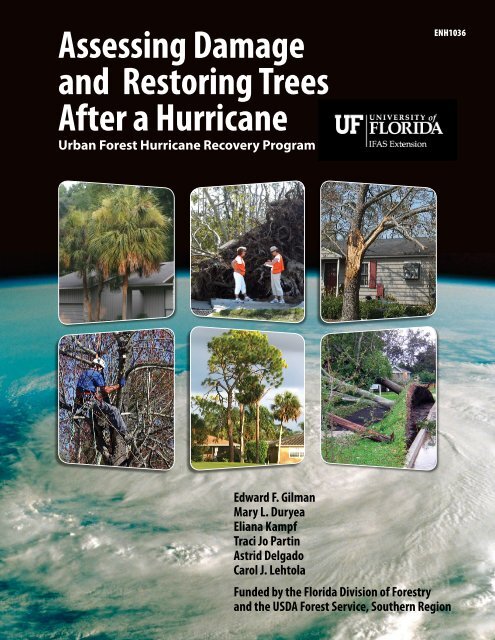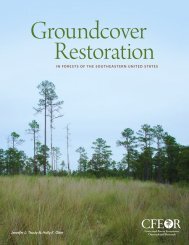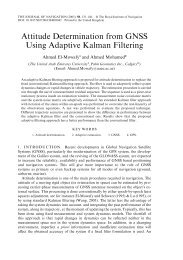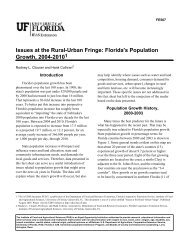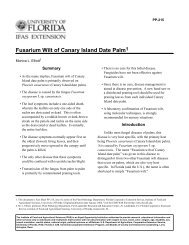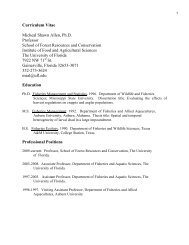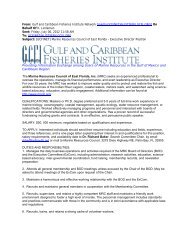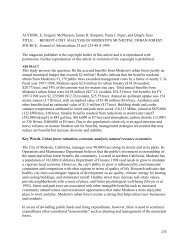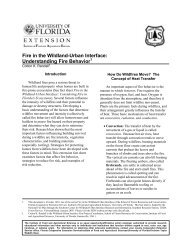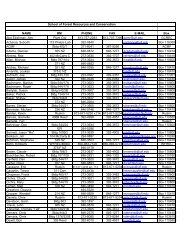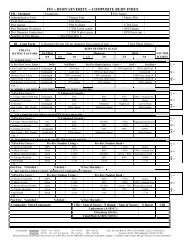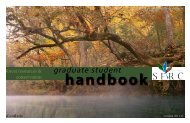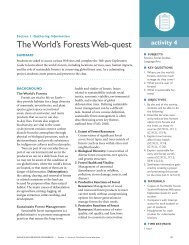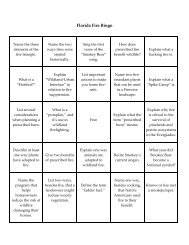Assessing Damage and Restoring Trees After a Hurricane
Assessing Damage and Restoring Trees After a Hurricane
Assessing Damage and Restoring Trees After a Hurricane
Create successful ePaper yourself
Turn your PDF publications into a flip-book with our unique Google optimized e-Paper software.
<strong>Assessing</strong> <strong>Damage</strong><strong>and</strong> <strong>Restoring</strong> <strong>Trees</strong><strong>After</strong> a <strong>Hurricane</strong>Urban Forest <strong>Hurricane</strong>Recovery ProgramKey ContentsSafety.. . . . . . . . . . . . . . . . . . . . . . . . . . . . . . . . . . . . . . . . . . 2Follow these guidelines for chain sawsafety, staying safe <strong>and</strong> hiring the rightprofessional during hurricane cleanup.<strong>Assessing</strong> <strong>Damage</strong>. . . . . . . . . . . . . . . . . . . . . . . . . . 4Learn to tell the difference betweentrees that should be removed <strong>and</strong> thosethat may recover.Restoration Pruning.. . . . . . . . . . . . . . . . . . . . . . . . 6Find out how to prune trees to restorethem back to health after a hurricane.<strong>After</strong> the devastation of the 2004 <strong>and</strong> 2005 hurricaneseasons, the USDA Forest Service provided grant funds tohelp communities recover. Urban forest recovery projectshave taken several forms, including new tree plantings,inventory <strong>and</strong> damage assessment, pruning programs, <strong>and</strong>replacing invasive plants with more wind resistant species.A team of scientists at the University of Florida/Institute ofFood <strong>and</strong> Agricultural Sciences (UF/IFAS) has been tracking<strong>and</strong> studying major hurricanes since <strong>Hurricane</strong> Andrew in1992 to determine their effects on the urban forest.The information in this publication was gained from thesestudies <strong>and</strong> is part of the Urban Forest <strong>Hurricane</strong> RecoveryProgram. The main goal of this program is to foster ahealthy urban forest that is more wind resistant. It is aimedat citizens <strong>and</strong> communities who seek to rebuild <strong>and</strong> setbetter management practices so that future storms are lessdevastating.Acknowledgments:We would like to acknowledge the Florida Division ofForestry <strong>and</strong> the USDA Forest Service, Southern Region forfunding the Urban Forest <strong>Hurricane</strong> Recovery Program.We thank the reviewers of this publication for their helpfulsuggestions: Hallie Dozier, Kevin Eckert, Les Fritz, SteveGraham, C. Way Hoyt, Sharon Lilly, Ed Macie, CharlieMarcus, Mike Marshall, Robert Northrop, Mike Orfanedes,Bruce <strong>and</strong> Lita Smith, Celeste White, <strong>and</strong> Larry Williams.Timothy Broschat provided valuable advice on palms <strong>and</strong>Kevin Eckert contributed safety photos <strong>and</strong> advice.Special thanks to Susan Gildersleeve, Tracy D. Zwillinger<strong>and</strong> Ashley Wood, UF/IFAS Information <strong>and</strong> PublicationsServices <strong>and</strong> Kelly Barber.Palms <strong>and</strong> Pines.. . . . . . . . . . . . . . . . . . . . . . . . . . . . 8Get specialized information for dealingwith palms <strong>and</strong> pines.Prevention.. . . . . . . . . . . . . . . . . . . . . . . . . . . . . . . . 10Learn how to design <strong>and</strong> manageurban forests for wind resistance byselecting the right tree <strong>and</strong> designingthe right location.Wind Resistant Species .. . . . . . . . . . . . . . . . . . . . 12Find out which tree species can survivehurricanes better.
Photo courtesy of Kevin EckertCleaning Up <strong>After</strong> a <strong>Hurricane</strong>Safety Comes First!Most injuries <strong>and</strong> deathsin a natural disaster occurduring cleanup. Safety mustbe the first concern.General safety tips• Do not work alone.• Keep a well stocked first-aid kitnearby <strong>and</strong> learn how to use it.• Avoid overexertion – this is the mostcommon cause for injury. Avoid liftingover 50 pounds. Remember to liftwith the legs <strong>and</strong> not the back.Appoint a flagger or use barricades <strong>and</strong> warning signsto control traffic or onlookers.Chain saw safetyChain saws are considered the most dangerous h<strong>and</strong> tool available. The risk ofinjury increases during hurricane cleanup when chain saws are widely used toremove trees <strong>and</strong> branches. Use these guidelines to avoid injuries:• Follow manual instructions carefully toensure safe operation <strong>and</strong> proper equipmentmaintenance.• Wear the appropriate personal protectiveequipment.• Keep both h<strong>and</strong>s on the h<strong>and</strong>les. Many chain sawinjuries affect the h<strong>and</strong>s <strong>and</strong> are the result of usingthe saw with just one h<strong>and</strong>.Cut at waist level or below.• Cut at waist level or below. Chain saw injuries tothe head often result from making overhead cuts.• Take extra care when cutting limbs that are bent, twisted, or caught underanother object. They may snap back <strong>and</strong> hit you or pinch the saw.• Take the time to do the job right. Most injuries affect the legs <strong>and</strong> feet <strong>and</strong> arethe result of aggressive or careless cutting. Take breaks when needed, becausemost injuries occur when workers are fatigued.• Shut off equipment when fueling the saw or carrying it a distance of more than100 feet, or through slippery areas or heavy brush.• Be sure the chain saw operator is aware of your presence before youapproach. Chain saw operators often cannot see or hear the approach ofother people.•Do not cut with the upper tip of the chain saw to avoid kickback.Photo courtesy of Kevin EckertDo not cut with the upper tip!Kickback occurs when the upper tipof the guide bar contacts an object<strong>and</strong> causes the saw to come straightback at the operator. Kickbackhappens so fast that there is no timefor reaction.How to prevent: Cut with the part ofthe bar closest to the engine. Watchwhere the tip is at all times – do notlet it contact the ground or otherbranches.2Create a safe work zone• Survey the site to identify potentialhazards <strong>and</strong> discuss where thereis potential for injuries. Agree oncommunication signals before youstart to work.• Set a perimeter around the work areathat is two times the height of thetree. More distance is required whenfelling trees or dropping limbs.• Mark the area with tape or cones <strong>and</strong>keep non-workers safely outside thisarea.Photo courtesy of Kevin EckertPersonal ProtectiveEquipment: reduces the likelihood ofinjury by covering key areas of the body.Storm damagecleanup is extremelydangerous, even forprofessionals!More safety information is availableat the Florida AgSafe web sitewww.flagsafe.ufl.edu
<strong>Assessing</strong> <strong>Damage</strong> <strong>and</strong>...Right after a wind storm or hurricane, communities <strong>and</strong> homeowners need to decide what to do with their storm damagedtrees. Although damage to trees may seem devastating, some trees can be treated <strong>and</strong> saved while others need to be removed.Some trees may not require any special treatment <strong>and</strong> can be left alone. These two possible approaches – removing orrestoring – will be discussed in detail to help you make an informed decision about trees in your yard.When to Remove a TreeThe lower trunk iscracked or broken• This tree has a largebroken branch <strong>and</strong> thecrack extends well intothe trunk. The crack willnot close <strong>and</strong> the treeposes a risk.• The remaining trunk islikely to fail.A large stem has splitfrom the tree• Notice the dark area atthe top of the split – it isa bark inclusion.• Bark inclusions (seearrow) are weak unionsbetween branches <strong>and</strong>are very susceptible tobreakage.Photo courtesy of Norm EaseyThe tree is leaningtowards a target• If a leaning tree is likely tofall on a person, building,power line, roadway orother high value target, itshould be removed.• Leaning trees usually havemajor roots broken, <strong>and</strong>are unsafe.The remaining treestructure is highlysusceptible tobreakage• Restoration is difficult forthis large tree because ofits poor initial structure(with multiple trunks,codominant stems <strong>and</strong>bark inclusions).The major roots aresevered or broken• Medium-aged <strong>and</strong>mature trees shouldnot be righted becausemajor roots are usuallysevered, making thetree unstable <strong>and</strong>unsafe.• Large trees need largeroots for structuralsupport.Large limbs are broken• <strong>Trees</strong> with most of thecanopy damaged due tolarge diameter (greaterthan 8 inches) branchbreakage are moredifficult to restore.Remember!If you remove a tree, plant another one in its place!For a list of wind resistant tree species, see page 12.4
...Deciding What to DoEven after experiencing high winds, many trees can be restored. However, restore only trees that have major limbs, trunk, <strong>and</strong>roots intact. To be a good c<strong>and</strong>idate for restoration a tree should not have cracks in major limbs or the trunk, decayed wood,or bark inclusions. Roots should not be exposed or lifted out of the soil. Also, make sure the branch <strong>and</strong> trunk structure weregood prior to the storm. See Preventive Pruning (page 10) for more on tree structure.The canopy isdefoliated• <strong>Trees</strong> that lose their leavesin a hurricane usually arenot dead.• Wait. New foliage may beproduced by the followingspring.• <strong>Trees</strong> <strong>and</strong> palms floodedwith salt water often loseleaves. Irrigate to washsalts through the soil.When to Restore a TreeNote: some species may not recover (see<strong>Assessing</strong> <strong>and</strong> <strong>Restoring</strong> Pines, page 9).Small branches arebroken or dead• <strong>Trees</strong> with small brokenbranches (less than 4inches diameter) caneasily be pruned <strong>and</strong>have a good chance ofrecovering.<strong>Assessing</strong> <strong>Damage</strong>Some major limbsare broken in decayresistant species• Live oak is one of themany species that aregood at resisting decay.Such species can berestored even if thereis some major branchbreakage.• Keep in mind thatyounger trees less than10 inches in diameterare easier to restore thanolder trees.Leaning or fallen treesare small• Only trees that wererecently planted or havea trunk diameter smallerthan 4 inches shouldbe stood back up orreplanted.• If you are consideringst<strong>and</strong>ing up large trees,seek professional advice.For a list of decay resistant species, seePreventive Pruning, page 10.Most of the canopyis damaged in decayresistant species• <strong>Trees</strong> that resist decaywell can lose much oftheir canopy <strong>and</strong> stillrecover after a storm.• Even with ¾ of theirsmall branches (lessthan 4 inches diameter)broken or removed by ahurricane, many decayresistant trees can berestored.How to re-establisha small tree1. Keep roots moist.2. Excavate the hole toaccommodate roots.3. Cut jagged or torn roots.4. Pull tree up as straight aspossible.5. Back fill with site soil.6. Water as if the treewere recently planted: 3gallons per inch of trunkdiameter, 3 times a week.7. Stake the tree. Adjuststakes regularly <strong>and</strong>remove when tree is stable.5
Restoration Pruning: <strong>After</strong> the StormClean the CanopyWhen hiring a certified arborist to restore your trees after ahurricane, know what to expect. A good restoration programbegins with cleaning <strong>and</strong> takes more than one visit to thetree. Immediately after the storm, the canopy should becleaned by removing hazards such as large dead branches<strong>and</strong> broken limbs. Cleaning also includes making smoothpruning cuts behind jagged branch tips to allow healthydevelopment of new growth. Very little live wood shouldbe removed because the tree is stressed, <strong>and</strong> needs to useenergy stored in the limbs to recover.Pruning plan• Before pruning, make sure the tree is restorable.• Determine whether the tree is personal or municipalproperty to avoid unnecessary expenses.• Look up! Use binoculars to check for broken branches inthe upper canopy, <strong>and</strong> look for cracks along limbs.• Remove broken, hanging limbs first.• Make clean cuts behind jagged tips of broken branches.• Do not remove live wood unless the limb is cracked <strong>and</strong>may hit a person or property.• Use a reduction cut as a first choice; if there is not a lateralbranch, use a heading cut.Make good pruning cutsPruning a limb is a three-step process.Step 1: Make an undercut about 12 inches from the trunk.Step 2: Make a topcut farther out on the limb.Step 3: Remove the stub with the final cut, being carefulnot to cut flush against the trunk or branch. Leave thecollar intact.What is the collar?The collar, labeled inthe diagram, is theswollen area at the baseof the branch whereit joins the trunk. Thetissue is rich in energyreserves <strong>and</strong> chemicalsthat hinder the spreadof decay. Good pruningcuts avoid cutting intothe collar.Removal cut<strong>After</strong> a hurricane this type of cutis used to remove broken, cracked,<strong>and</strong> hanging limbs. A removal cutprunes a branch back to the trunkor parent branch. Remove hanginglimbs first so that branches do notfall <strong>and</strong> cause injury. Use cautionwhen removing broken limbs toavoid injuring other branches orthe trunk.Reduction cutThis type of cut is used for makingclean cuts behind jagged tips ofbroken branches. A reduction cutshortens the length of a stem bypruning back to a smaller limb,called a lateral branch. The lateralshould be at least 1 /3 the diameter ofthe pruned branch, as shown in thepicture. Reduction cuts are a betteroption than heading cuts.Cleaning the canopy: The red lines indicate where to make pruning cuts on this tree.During restoration, water the tree indry periods to alleviate stress.In most cases, fertilization is not necessary.6Heading cutAlthough not usually recommendedfor routine pruning, heading cutsare sometimes appropriate ondamaged trees if removing theentire limb would remove toomuch live wood. The food stored inlive limbs helps the tree to sprout<strong>and</strong> produce new leaves. A headingcut is made at a node along thestem, leaving a stub.
Restoration Pruning: A Few Years LaterReduce Some, Remove Some, Leave SomeA management strategy for sprouts onrecovering treesThe next step in restoration is managing sprouts to build structureback into the tree. Sprouts should be allowed to grow for a few yearsbefore any major pruning is performed. Remember: sprouts are a signof recovery! Sprouts work to restore the tree’s ability to make food,taking the place of the leaves lost in the hurricane. As sprouts getlarger <strong>and</strong> start to compete with each other for light <strong>and</strong> space, theirgrowth rate will slow. At this point, 1 /3 of the sprouts can be removed,1/3 reduced (or cut shorter), <strong>and</strong> the rest left to become the newbranches. Keep in mind that this process will need to be repeatedover a period of years, <strong>and</strong> the length of time needed for restorationwill depend on factors like damage severity <strong>and</strong> size of the tree.Before restoration pruning<strong>After</strong> restoration pruningNew leader• Reduce• RemoveThe goal of sprout management is for the new leader toclose over the pruning cut.Broken stem Reduced back to lateral Sprout closing over cutHere is a young tree broken in the storm. The stem on the leftreceived a reduction cut (dotted line). Several sprouts emerged fromthe cut. Competing sprouts were shortened, then removed. Thepicture on the right shows the tree one year later, <strong>and</strong> the remainingsprout is closing over the cut. Branches larger than 4 inches indiameter are less likely to close over.<strong>After</strong> RestorationBuild strong structureBegin structural pruning by either reducing orremoving codominant stems. See Preventive Pruning(page 10) to learn more.7How long doesrestoration take?• Age: young trees recover faster because theyare more vigorous.• Size: large trees may require more pruningvisits to correct structural problems.• Amount of damage: severely damaged treesneed more time for restoration.• Species: decay resistant trees are more likely tohave a strong recovery.• Health: trees in poor health before thehurricane are less likely to recover.Is a heading cut the sameas topping?No! Topping is a harmfulpractice where theentire canopy of a treeis severely reduced withmany large heading cuts.Topping (also called hatracking)can lead to decay<strong>and</strong> reduce tree vigor.Heading cuts should notbe used as a st<strong>and</strong>ardTopping – the entirecanopy has been reducedwith heading cuts; veryharmful to the tree.practice on healthy trees.When are heading cutsacceptable?Storm damaged trees maynot have a lateral branchpresent for making a goodreduction cut. In thatcase, a heading cut may beHeading cut – thissmall branch of a stormdamaged tree can berestored through sproutmanagement.Listed below are factorsto consider that affect theamount of time trees willneed for recovery.preferred over removingthe limb. Removing anentire limb could reduceenergy reserves in the tree,create a large trunk wound,<strong>and</strong> lead to decay.Restoration Pruning
<strong>Assessing</strong> <strong>and</strong> <strong>Restoring</strong> PalmsdeadrestorableCanopy CleaningRemove or Restore?Is my palm dead or alive? Will it recover? These are commonly asked questions afterhurricanes. Palms grow differently from other trees. The growing point of a palm is locatedat the top of each trunk, surrounded by leaves (called fronds). All fronds originate from thisone point (called the bud). If the bud is severely damaged or killed, new leaves fail to develop<strong>and</strong> single-stemmed palms will die. On multi-stemmed palms, the undamaged trunks couldrecover as long as their buds are not damaged. If the trunk is snapped in half, the palm is dead.However, for palms left st<strong>and</strong>ing, the bud is often not visible or accessible, making it difficult todetermine whether it is damaged. For these palms, follow these guidelines:• Allow at least 6 months or longer for palms to put out new growth.New leaves may be stunted, discolored or abnormally shaped.• It may take 1 to 2 years or more before palms appear normal with a full canopy.• Irrigate 3 times a week for 6 weeks if there is not sufficient rainfall; longer ifdrought persists.Step 1: Remove hanging or dead fronds that could fall <strong>and</strong> hit a person or damage property.Step 2: Remove fronds that cover the bud so that new fronds can emerge.Step 3: Leave bent fronds attached to the palm until new fronds fully emerge; green frondshelp recovery.Step 4: Leave fronds with any green color, even if they are yellowing or have brown tips.Establish a fertilization program to correct nutrient deficiencies (refer to publicationENH 858, Fertilizer Recommendations for L<strong>and</strong>scape Plants, http://edis.ifas.ufl.edu/EP114)leavelivefrondsStep 1Dead or broken frondsshould be removed becausethey pose a hazard. Noticethe bent, green fronds alongthe trunk in the backgroundthat are still attached. Theseshould be kept until newfoliage fully emerges becausethey help the palm regainenergy reserves.Recovery fromstorms is not aquick process, sohave patience withyour palms!Step 3Leave bent fronds such asthese for now. They are stillgreen <strong>and</strong> providing energyto the palm.remove dead or broken frondsStep 2Remove fronds that couldimpede new growth. Whenbroken fronds cross over thetop of the palm, they maysuppress new growth fromthe bud.8Step 4This palm is showing severeyellowing on the lowerfronds because it lacksnutrients such as potassium<strong>and</strong> magnesium. Yellowingor browning fronds stillprovide energy for growth,<strong>and</strong> removing too much ofthis foliage reduces palmvigor. Begin an appropriatefertilization program tocorrect nutrient deficiencies.
Prune Palms CorrectlyCorrectly pruned palmsOften palms are over-pruned to look like the photo onthe right. Arborists report that palms with too manyfronds removed suffered more damage in hurricanesthan palms that were not pruned. Removing too manyfronds exposes the delicate bud to more wind <strong>and</strong>more potential damage. Palms need fronds to protectthe bud <strong>and</strong> provide nutrients for growth.Over-pruned palmsOver-pruning is harmful for palms• Takes away food-producing fronds.• Reduces health.• Leads to stress <strong>and</strong> decline.• Attracts pests.• Takes a year or more to regrow a full canopy.• Makes them more susceptible to wind damage.Palms <strong>and</strong> Pines<strong>Assessing</strong> <strong>and</strong> <strong>Restoring</strong> PinesRemove or Restore?Pines are very sensitive to wind damage. They can snap, uproot or lean duringstorms. A pine still st<strong>and</strong>ing after a hurricane may have internal damage that isnot visible. Before making a decision, wait <strong>and</strong> see if the tree lives.• Pines may die slowly over a period of 6 months to 2 years after wind storms.• Some may remain green for a year or more, then suddenly turn yellow <strong>and</strong>quickly progress to brown needles.• Pines with all brown needles are dead <strong>and</strong> should be removed.• Monitor pines carefully for insects. Weakened pines may be more susceptible tobeetles <strong>and</strong> diseases.Canopy Cleaningleavebranchwith yellowneedlesremovebrokenbranchStep 1: Remove hazards, such asdead, broken <strong>and</strong> hangingbranches.Step 2: Remove branches with noneedles or brown needles.Step 3: Leave branches with yellowneedles for now.Step 4: Wait <strong>and</strong> see how pines dothe following year.9What causesyellowing of theneedles <strong>and</strong>pine death?The causes are not completelyunderstood, but it is likely dueto hidden damage produced bybending <strong>and</strong> twisting duringhurricane force winds. Prolongedwinds may also rupture smallerroots without breaking the largersupport roots. The injured stems<strong>and</strong> roots are unable to supplythe water <strong>and</strong> nutrients neededin the crown, resulting in yellowneedles <strong>and</strong> pine decline.
Preventive PruningStrong StructureCan Reduce <strong>Damage</strong>The urban forest is much different from a natural forest.<strong>Trees</strong> often develop a form that is more susceptible tobreakage when growing in urban environments. As a result,trees need preventive pruning to develop strong structure.Research <strong>and</strong> observation show that well pruned trees cancreate a more wind resistant urban forest. Listed below arethe key components of strong structure.Codominant stems are weaklyattached, <strong>and</strong> more likely to splitfrom the tree in strong winds.Strong branch unionsOne dominanttrunk<strong>Trees</strong> with branches less than½ the trunk diameter have onedominant trunk. A tree withtwo or more trunks is said tohave codominant stems, orstems of equal size originatingfrom the same point on thetree. This form is weak.How to BuildStrong StructurePruning to create stronger tree structure is an ongoingprocess known as structural pruning. The drawings belowshow how to achieve each principle of strong structurethrough making proper reduction <strong>and</strong> removal cuts. Referto Restoration Pruning (page 6) to learn more about how tomake good reduction <strong>and</strong> removal pruning cuts.Pruning young treesPruning mature treesDevelop one dominanttrunk by shorteningcompeting branches withreduction cuts. Whenperformed regularly, thismakes trees stronger byallowing the main trunk togrow larger than branches.To minimize the likelihoodof tree damage:Strong attachments formwhen the union of the trunk<strong>and</strong> branch is u-shaped.Weak attachments areindicated by a v-shapedunion.Reduce the length of limbswith a weak attachmentto the trunk. Also, reducelimbs that are more than ½the diameter of the maintrunk or extended beyondthe main canopy.<strong>Trees</strong> pruned in this manner resultin unbalanced canopies that breakin storms.Balanced canopyThe canopy of the tree shouldbe evenly distributed. Whenonly interior branches areremoved the tree becomesunbalanced because foliageis concentrated at the tips ofbranches. This form is moresusceptible to breakage <strong>and</strong>difficult to restore.Before pruning<strong>After</strong> pruningBalance the canopy byreducing the length oflimbs on the side whereweight is concentrated.Do not remove interiorbranches, as thisconcentrates foliage at thetips of branches <strong>and</strong> causesthem to break in strongwinds.Decay resistant trees<strong>Trees</strong> that resist decay are likely to recover well after a hurricane. Decay-prone trees can become a risk when severely damaged.<strong>Trees</strong> that resist decay<strong>Trees</strong> prone to decayButtonwood, Conocarpus erectusAfrican tuliptree, Spathodea campanulataLive oak, Quercus virginianaHong-Kong orchid, Bauhinia blakeanaMahogany, Swietenia mahoganiLaurel oak, Quercus laurifoliaTamarind, Lysiloma latisiliquumRedbay, Persea borboniaWinged elm, Ulmus alataRed maple, Acer rubrum10
Design <strong>and</strong> Manage Communitiesfor Wind ResistanceDesign the Right Place Select the Right Tree<strong>Trees</strong> growing in groups survive hurricanewinds better than trees planted individually.Tree Management: Evaluate <strong>Trees</strong> for Hazard PotentialHazard: internal trunk decay.Do not wait until thelast minute to prepareyour trees for stormseason! Take actionnow. Hire an ISAcertified arborist.Researchers whovisited post-hurricanesites found that manytree failures couldhave been preventedwith good design. Themost important designelement that is oftenoverlooked is havingenough soil space fortree roots to grow. Toprovide anchoragefor the tree, roots need to spread beyond the edge of thecanopy <strong>and</strong> grow deep into the soil. Both homeowners <strong>and</strong>community planners should make sure there is space for treegrowth when choosing to plant large maturing trees.Provide space for growth• Plant trees in soil spaces according to their mature size:- large trees: at least 30 feet x 30 feet.- medium trees: at least 20 feet x 20 feet.- small trees: at least 10 feet x 10 feet.• Soil should have plenty of open surface space to allowgrowth of trunk <strong>and</strong> main flare roots.• Ideally, soil should be well drained to allow roots to grow atleast 3 feet deep to anchor trees.• Group trees together in large spaces rather thanindividually in many small spaces.• Do not plant right next to a house, wall or any otherstructure.Choose trees thatresist decay <strong>and</strong>therefore recoverwell from winddamage. Smallmaturing trees (30feet at maximumheight) are oftena better choice forareas where thereis not enough soilspace for largematuring trees.Make sure trees are adapted to local site conditions, suchas dry versus wet soils. See Wind Resistant Tree Species (page12) for a list of trees to plant. For more information onselecting trees for Florida <strong>and</strong> southeast U.S. go tohttp://orb.at.ufl.edu/Florida<strong>Trees</strong>.Consider small maturing trees• When planting near power lines.• When planting within 10 feet of curbing, building or anyother obstruction.• When the space is inadequate for root growth or the soilis shallow, compacted or poorly drained. Large trees canblow over due to shallow roots.Large trees are more likely to be damaged in a hurricane. When suchtrees are located near a home, property damage could be reduced byhaving a professional arborist evaluate the trees to assess risk <strong>and</strong> treatproblems. Here are some things to look for:• Know the species of the tree. Is it prone to decay? How long is the lifespan? <strong>Trees</strong> near the end of their lives are at greater risk of failure.• Check the health of the tree. Look for defects such as root rot <strong>and</strong>internal trunk decay. A tree can appear perfectly healthy on the outside<strong>and</strong> have serious flaws that require attention (see photo at left).• Is the structure strong or weak? Become familiar with the componentsof strong structure to decide (page 10).• Evaluate previous cultural practices. Have the roots been cut duringconstruction? Is the tree located near a paved surface? Has the tree been topped or poorlypruned? These situations can increase likelihood of failure.• Is the canopy very dense? <strong>Trees</strong> with dense canopies can be made more wind resistant byremoving small branches from the outer edge of the canopy. Interior branches should not beremoved.11Small maturing trees are nicely suited for this sitebecause of overhead power lines <strong>and</strong> small soilspace.Hazard: major support rootscut.Prevention
Wind ResistantTree SpeciesThese wind resistant tree lists were developed from research of tenhurricanes which struck the Southeast U.S. Coastal Plain, SouthFlorida <strong>and</strong> Puerto Rico between 1992 <strong>and</strong> 2005. In addition,a survey of arborists, scientists <strong>and</strong> urban foresters contributedinformation to rank wind resistance. The recommended treespecies are divided into the Southeast U.S. Coastal Plain region(which includes USDA hardiness zones 8 <strong>and</strong> 9) <strong>and</strong> Tropical <strong>and</strong>Subtropical regions (including USDA hardiness zones 10 <strong>and</strong> 11).U.S. Southeast Coastal PlainAmerican hophornbeam, Ostrya virginianaBaldcypress, Taxodium distichumBeech, blue, Carpinus carolinianaChickasaw plum, Prunus angustifoliaCommon persimmon, Diospyros virginianaCrape myrtle, Lagerstroemia indicaDogwood, Cornus floridaFringe tree, Chionanthus virginicusHickory, Florida scrub, Carya floridanaHickory, mockernut, Carya tomentosaHickory, pignut, Carya glabraHolly, American, Ilex opacaHolly, dahoon, Ilex cassineHolly, yaupon, Ilex vomitoriaInkberry, Ilex glabraMagnolia, saucer, Magnolia x soulangianaMagnolia, southern, Magnolia gr<strong>and</strong>ifloraMagnolia, sweetbay, Magnolia virginianaMaple, Florida sugar, Acer saccharum subsp. floridanumMaple, Japanese, Acer palmatumOak, live, Quercus virginianaOak, myrtle, Quercus myrtifoliaOak, post, Quercus stellataOak, s<strong>and</strong> live, Quercus geminataOak, Shumard, Quercus shumardiiOak, swamp chestnut, Quercus michauxiiOak, turkey, Quercus laevisPodocarpus, Podocarpus spp.Pondcypress, Taxodium ascendensRedbud, Cercis canadensisRiver birch, Betula nigraSparkleberry, Vaccinium arboreumSweetgum, Liquidambar styracifluaTupelo, black, Nyssa sylvaticaTupelo, water, Nyssa aquaticaWhite ash, Fraxinus americanaWinged elm, Ulmus alataPalmsCabbage, Sabal palmettoDate, Canary Isl<strong>and</strong>, Phoenix canariensisDate, Phoenix dactyliferaPindo, Butia capitata12LouisianaIn the University of Florida/IFAS wind resistance study, urban forests weremeasured after 10 hurricanes. For each hurricane, the maximum sustained windspeed at l<strong>and</strong>fall (mph) <strong>and</strong> year are listed.Tropical <strong>and</strong> SubtropicalBaldcypress, Taxodium distichumButtonwood, Conocarpus erectusCocoplum, Chrysobalanus icacoCrape myrtle, Lagerstroemia indicaFalse tamarind, Lysiloma latisiliquuumGeiger tree, Cordia sebestenaGumbo limbo, Bursera simarubaHickory, Florida scrub, Carya floridanaHolly, dahoon, Ilex cassineIronwood, Krugiodendron ferreumLignumvitae, Guaiacum sanctumLychee, Litchi chinensisMagnolia, southern, Magnolia gr<strong>and</strong>ifloraMagnolia, sweetbay, Magnolia virginianaMahogany, Swietenia mahagoniMastic tree, Sideroxylon foetidissimumOak, live, Quercus virginianaOak, s<strong>and</strong> live, Quercus geminataParadise tree, Simarouba glaucaPigeon plum, Coccoloba diversifoliaPodocarpus, Podocarpus spp.Pondapple, Annona glabraPondcypress, Taxodium ascendensSatinleaf, Chrysophyllum oliviformeSea grape, Coccoloba uviferaStopper, boxleaf, Eugenia foetidaStopper, redberry, Eugenia confusaStopper, white, Eugenia axillarisSweetgum, Liquidambar styracifluaTupelo, black, Nyssa sylvaticaPalmsAlex<strong>and</strong>er, Ptychosperma elegansAreca, Dypsis lutescensBottle, Hyophorbe lagenicaulisBlue latan, Latania loddigesiiCabbage, Sabal palmettoChinese fan, Livistona chinensis*Coconut, Cocos nuciferaDate, Canary Isl<strong>and</strong>, PhoenixcanariensisDate, Phoenix dactyliferaDate, pygmy, Phoenix roebeleniiFishtail, Caryota mitisFlorida silver, CoccothrinaxargentataManila, Adonidia merrilliiPindo, Butia capitataRoyal, Roystonea elataSpindle, Hyophorbe verschaffeltiiThatch, key, Thrinax morrisiiThatch, Florida, Thrinax radiataTriangle, Dypsis decaryi* Caution: manage to prevent escape (as recommended by IFAS http://plants.ifas.ufl.edu/assessment.html)We present these lists with the caveat that no tree is perfectly wind-proof <strong>and</strong> that many other factors contribute to wind resistance including soil conditions, wind intensity, previouscultural practices, tree health <strong>and</strong> age. These lists do not include all trees that could be wind resistant. They list those species encountered during our studies in large enough numbers torun statistical comparisons.TexasRita120 mph2005Puerto RicoMississippiKatrina125 mph2005George110 mph1998AlabamaIvan130 mph2004Erin85 mph1995Opal125 mph1995Dennis120 mph2005GeorgiaFloridaCharley145 mph2004Jeanne120 mph2004Andrew165 mph1992
Establishing <strong>Trees</strong> for a Healthy <strong>and</strong>Wind Resistant Urban ForestA healthy <strong>and</strong> more wind resistant urban forest depends on managing existing trees <strong>and</strong> establishingnew trees properly. When planting new trees, consider these recommendations:Plant tree species that are more windresistant, such as cabbage palms.Match recommended species to thelocal site conditions.Consider planting trees in groups(at least five trees) as opposed toindividually.Wind Resistant SpeciesGive trees adequate rooting space (withno obstructions).Plant a variety of species, ages <strong>and</strong>layers of trees <strong>and</strong> shrubs to maintaindiversity in your community.Consider soil properties (soil depth,water table <strong>and</strong> compaction). Thisporous surface reduces runoff <strong>and</strong>improves root health.Plant high quality trees with goodstructure (Florida #1 or Florida Fancy).Plant considering the aerial spaceneeded for a mature-sized tree.Establish a structural pruning programearly on. Reduce the length of branchescompeting with the main trunk.13
This publication is also available electronically at http://edis.ifas.ufl.edu/EP291This document is ENH1036, one of a series of publications from the Urban Forest <strong>Hurricane</strong> Recovery Program in the School of Forest Resources <strong>and</strong>Conservation <strong>and</strong> the Environmental Horticulture Department, Florida Cooperative Extension Service, Institute of Food <strong>and</strong> Agricultural Sciences,University of Florida. Original publication date July, 2006.The Institute of Food <strong>and</strong> Agricultural Sciences (IFAS) is an Equal Opportunity Institution authorized to provide research, educational information<strong>and</strong> other services only to individuals <strong>and</strong> institutions that function with non-discrimination with respect to race, creed, color, religion, age, disability,sex, sexual orientation, marital status, national origin, political opinions or affiliations. U.S. Department of Agriculture, Cooperative ExtensionService, University of Florida, IFAS, Florida A. & M. University Cooperative Extension Program, <strong>and</strong> Boards of County Commissioners Cooperating.Larry Arrington, Dean


